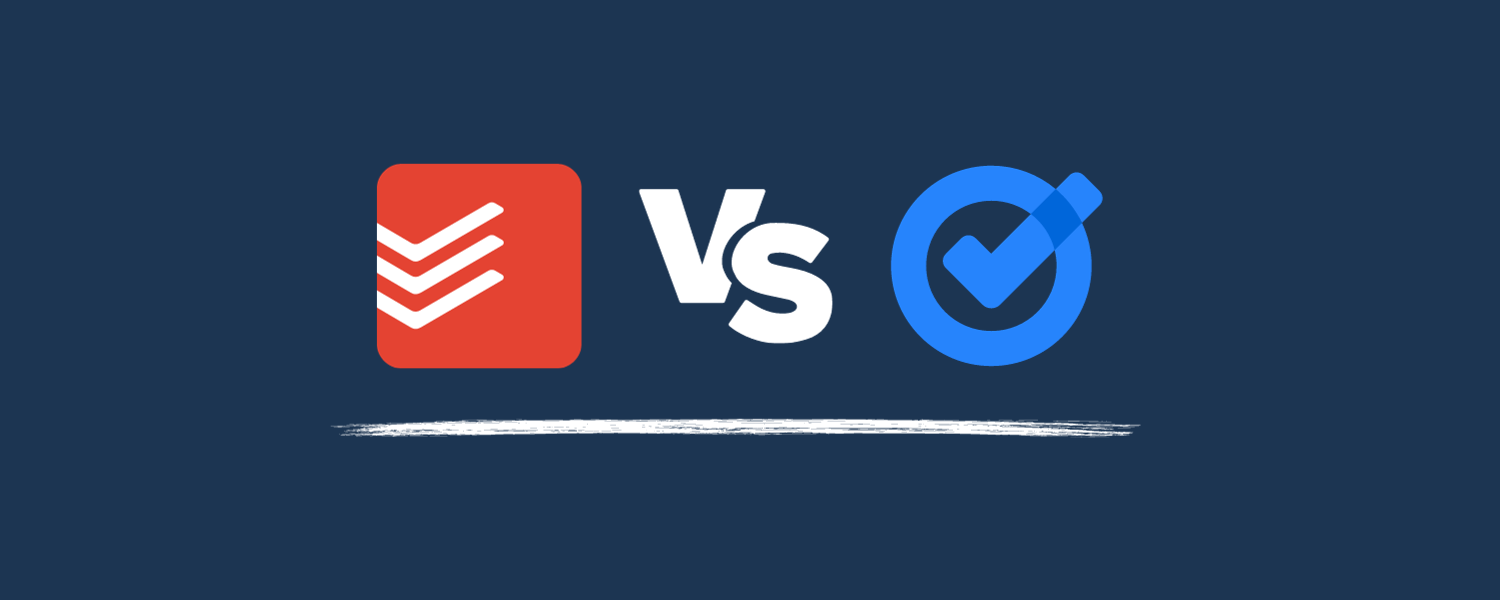Staying on top of tasks and to-dos and getting things done are ongoing challenges in our busy modern lives. Juggling work projects, family responsibilities, and daily errands can quickly become overwhelming if you don’t use the right tools for organization and productivity. Fortunately, there are some great task management apps available today that can help. Two of the most popular options are Todoist and Google Tasks, which are constantly updated with new features. Keep reading to know which one is the best for you in 2024.
Table of contents
Todoist vs. Google Tasks: Overview
| Feature | Todoist | Google Tasks |
|---|---|---|
| User interface | More advanced interface with more features and configuration options | Simple, streamlined interface focused just on task management |
| Task creation | Quick add options from any screen Detailed task creation forms with priority, project, label, and date settings |
Basic add task form and quick task creation from Gmail inbox |
| Task organization | Robust tools like customizable projects, labels, filters, and scheduling | Basic lists for grouping tasks |
| Sub-tasks | Yes | Yes |
| Reminders/Due dates | Many options for due dates and reminders per task, calendar view | Due dates and basic reminders per task |
| Integrations | Integrates with over 100 apps such as Google Calendar, Alexa, Slack, etc. | Built into Gmail, syncs with Google Calendar |
| Extensions/plugins | Add-ons available to enhance features | Leverages Google add-ons |
| Platforms | Windows, macOS, iOS, Android, and various browser extensions | Android, iOS, and web browser |
| Price | Free plan with basic features Pro Plan at $4/month for a single user |
Free for all users with a Google account |
Todoist vs. Google Tasks: What are the differences?
Let’s review and compare all the differences between Todoist and Google Tasks.
Interface and user experience
Todoist
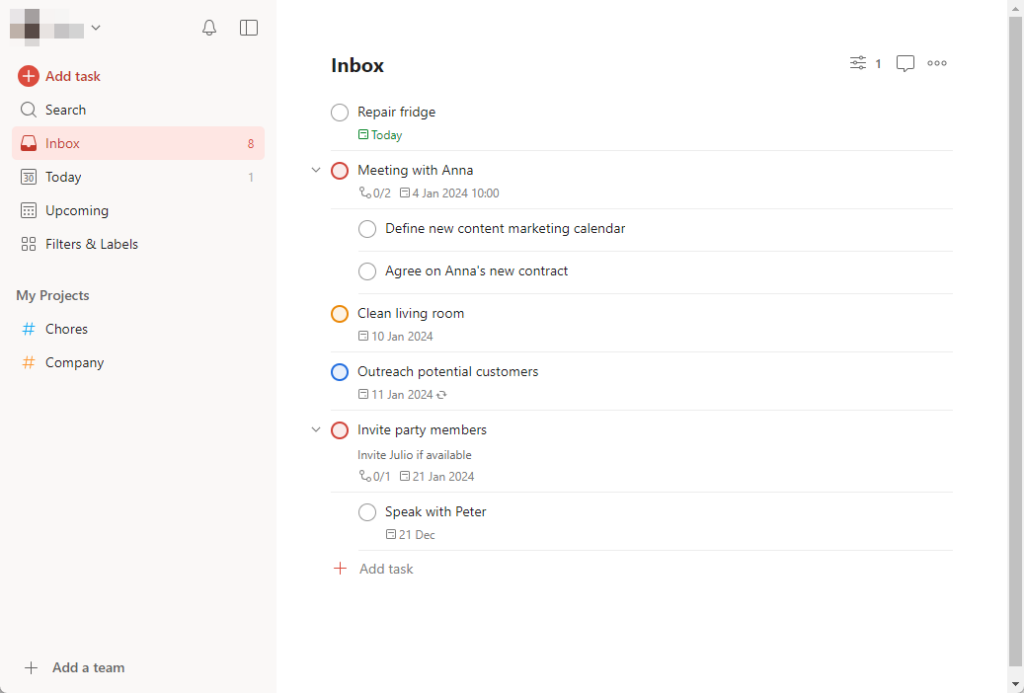
Todoist presents a feature-rich interface upon start-up. Its design is both functional and visually appealing, adhering to modern Material Design principles.
The process of creating tasks in Todoist is straightforward, but it offers additional options like adding labels, sub-tasks, and reminders, setting priorities, and sharing projects. This makes Todoist a more versatile tool, especially for users who require a more detailed and structured approach to task management.
Todoist’s interface is designed to handle more complex task management needs. The sidebar menu categorizes tasks into various sections, such as Inbox, Today, and Upcoming, helping users focus on immediate tasks while still keeping an eye on upcoming responsibilities.
This level of organization is beneficial for users who manage a large number of tasks or those who need to keep track of tasks across different projects or areas.
Google Tasks
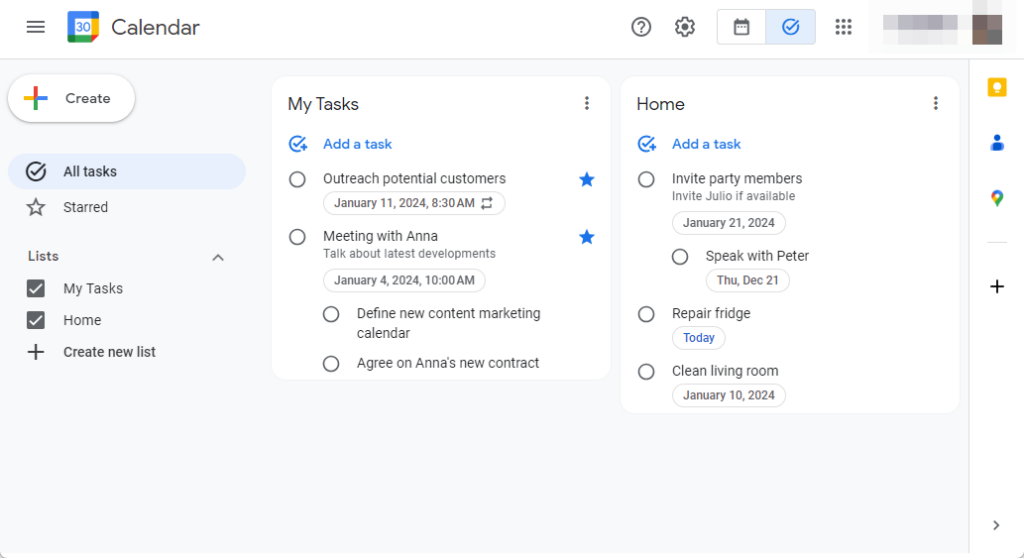
In contrast, when you first open Google Tasks, you’re greeted with an even more minimalist interface that prioritizes simplicity and ease of use.
The design of the application is simple and offers a straightforward approach to managing tasks divided into lists. Creating a new task is as simple as tapping the “Add a task” button and filling in the details, date, and time.
Google Tasks’ minimalist design focuses on the essentials, making it an excellent choice for users who need a basic, easy-to-use task manager. The primary interface revolves around a simple list view, where tasks can be added, checked off, and organized with minimal effort.
Mobile apps
Todoist
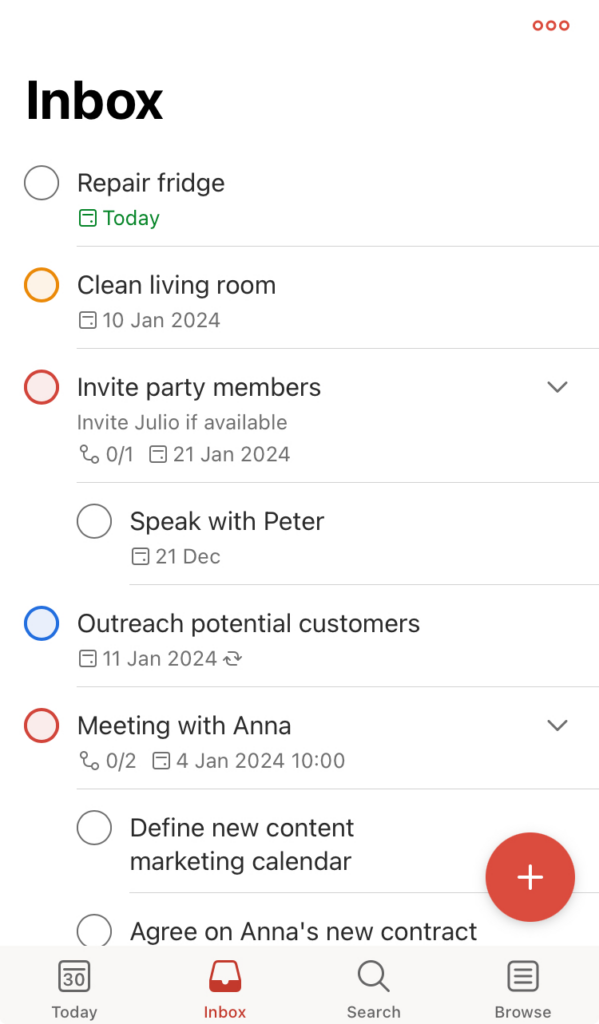
Todoist’s mobile application extends its user-friendly design to smaller screens, maintaining a consistent look with its desktop counterpart.
The app’s interface is clean and intuitive, allowing users to easily navigate their tasks and projects. Despite its compact size, the mobile version doesn’t compromise on functionality. Users can create tasks, assign priorities, and organize with labels just as they would on a desktop.
Additionally, Todoist ensures seamless synchronization across devices, making it a reliable tool for managing tasks on the go.
Google Tasks
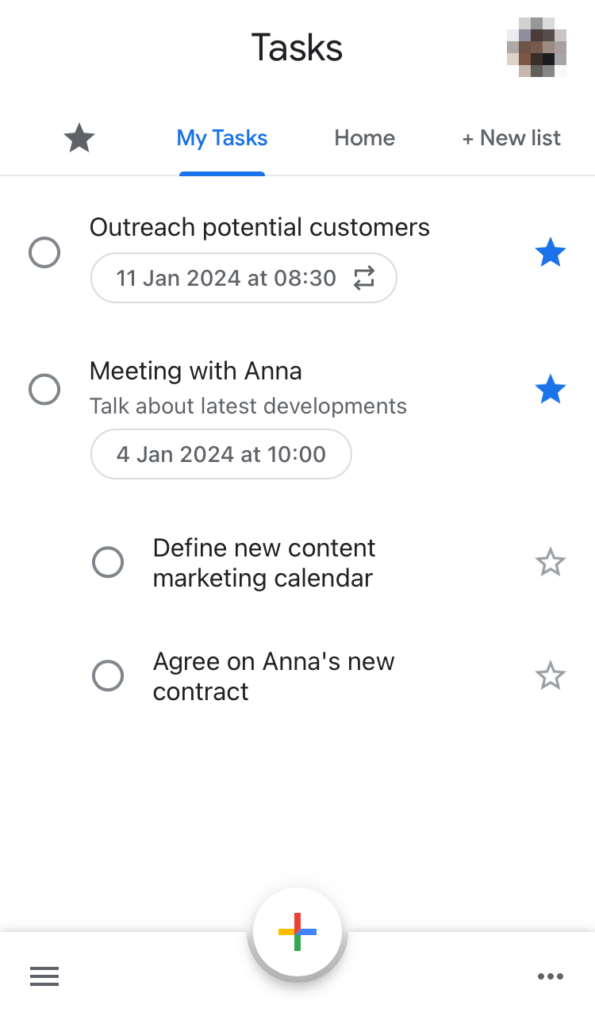
On the other hand, the Google Tasks mobile app adheres to a minimalist approach. The interface is straightforward, focusing primarily on task management without the complexity of additional features.
This simplicity is part of its charm, especially for users who prefer a more streamlined experience.
The app integrates smoothly with other Google services like Gmail and Google Calendar, allowing users to manage tasks within the familiar Google ecosystem.
Google Tasks for mobile is an excellent option for those who need a basic and efficient tool to manage daily tasks and synchronize them between devices.
Advanced features
Todoist
Todoist stands out with its comprehensive task management capabilities. At its core, it allows for detailed organization of tasks into projects and sections, which users can color-code for differentiation. This feature is particularly beneficial for managing complex workflows or segregating professional and personal tasks.
When setting up a new project in Todoist, users can choose between a traditional “List” project or a “Board” project. This flexibility allows for planning and managing projects using the Kanban method. Users can easily switch between list and board views, offering diverse perspectives on the project’s progress.
👉 Learn more: 10 Best Kanban Software in 2024
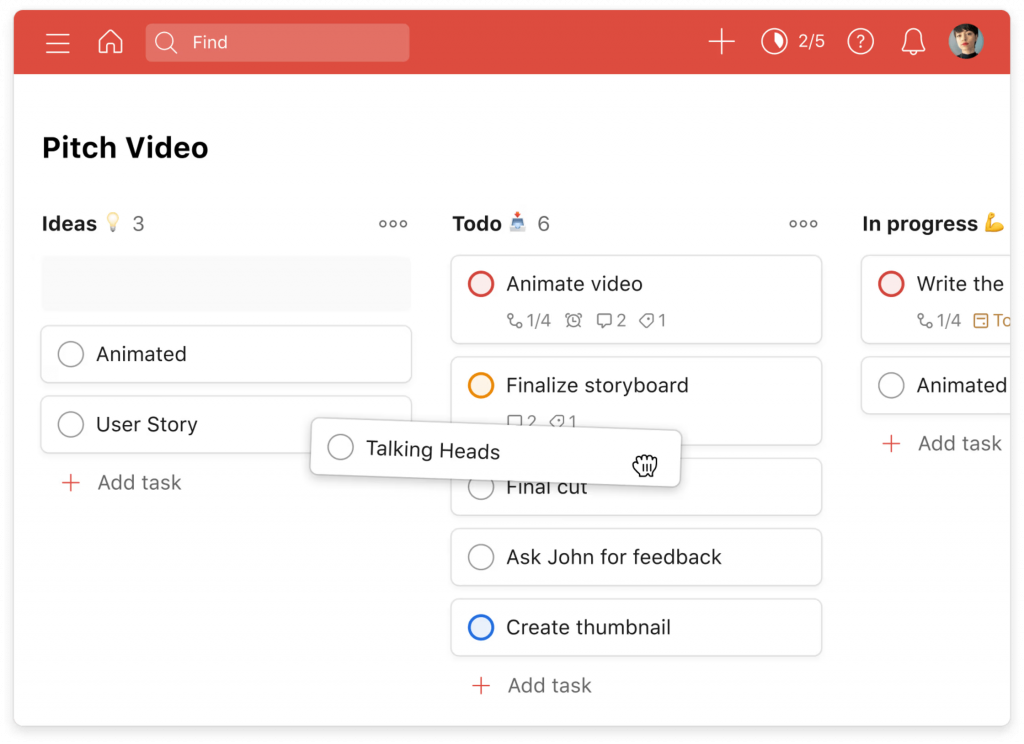
One of the standout features of Todoist is its natural language input. This intuitive feature simplifies task creation, allowing users to quickly add tasks using plain English right at the task’s title (for example, email George every Tuesday at 5 pm). This function is handy for on-the-go task entry and creating recurring tasks.
The app also offers a suite of productivity reports, which provide insights into task completion trends, activity logs, and a unique Karma system that tracks productivity. Such features are instrumental in helping users analyze their productivity patterns over time and encouraging habit tracking.
Google Tasks
While simpler than Todoist, Google Tasks offers features that cater to essential task management needs. Its primary function revolves around creating tasks and sub-tasks and organizing these into different lists.
The integration of Google Tasks with the broader Google ecosystem, notably Google Calendar and Gmail, is a remarkable feature. Users can convert emails into tasks directly from Gmail and view them in Google Calendar, offering a unified view of their schedules and to-dos.
Google Tasks also caters to essential task management functions, such as setting due dates and receiving desktop notifications.
In addition, Tasks supports the creation of recurring tasks, an essential feature for tasks that need to be performed regularly. Adding attachments and detailed notes to tasks further enhances its utility, providing users with a comprehensive view of each task’s requirements.
As you would expect from a Google product, it also includes a powerful search tool, a vital feature for quickly locating specific tasks, especially when there are many of them spread across multiple lists and dates.
Teamwork and collaboration
Todoist
Todoist is tailored for collaborative work, offering a suite of features that facilitate teamwork and project management:
- Creating and managing teams. Todoist allows users to create a team, serving as a shared home for the team’s tasks and projects. Every team member can browse, preview, or join active or archived projects, making it a centralized hub for collaborative work.
- Project sharing and task assignment. Teams can start by creating projects for significant tasks and listing relevant tasks. Sharing these projects with team members is as simple as clicking the share icon, and members must join a project to be assigned tasks and tagged in comments. The app emphasizes clarity in task responsibility. Each task can only be assigned to one person, eliminating ambiguity about who is responsible for what.
- Enhanced communication and reporting. Todoist facilitates in-task communication with the ability to discuss details and upload files in comments. It also offers an activity log to provide a snapshot of the team’s work and customizable project reports with its Google Sheets extension. These features enable teams to document and report on project status efficiently.
Google Tasks
While Google Tasks doesn’t offer extensive built-in collaboration features like Todoist, it provides some functionality, especially when used with TasksBoard, a third-party integration.
- Integration with TasksBoard. Once integrated with TasksBoard, users can share their task lists via a link. It also allows users to create multiple task boards in the paid premium plans. The free version of TasksBoard allows sharing with up to five people, facilitating basic collaboration.
- Exporting tasks to Google Sheets with TasksBoard. For users who need to keep track of task progress or due dates in a more detailed format, TasksBoard offers the option to export task lists to Google Sheets. This feature can be accessed from the tasks list menu, enabling users to create a comprehensive spreadsheet of tasks. This function can be crucial for detailed project management or reporting.
- Task list sharing. Sharing a task list in Google Tasks is a straightforward process. Users can click on the three-dot menu next to the chosen task list and select “Share List.” This generates a shareable link, which, when given to others, allows them to view and edit the task list. This feature is useful for small teams or groups working on shared tasks or projects.
Limitations and drawbacks
Todoist
- Limited free version. Todoist’s free plan comes with restrictions, notably lacking features like reminders, labels, and advanced filters. This might limit its utility for users unwilling to pay for the premium version.
- Customization limitations. Users have limited control over the interface customization, such as adjusting font sizes or layout preferences, which can affect the user experience.
- Complexity for simple needs. Todoist’s plethora of features might seem overwhelming and unnecessary for users seeking a straightforward task management tool.
- Challenges in data entry. Adding notes or scheduling repeating tasks can be less intuitive compared to other apps, and moving items within the outline hierarchy can be cumbersome.
Google Tasks
- Basic functionality. Compared to alternatives like Todoist, Google Tasks is quite basic, offering fewer features and less flexibility in task management.
- Limited collaboration features. Google Tasks lacks robust native collaboration features, making it less ideal for team-based project management. While third-party tools like TasksBoard can remedy this, they require additional setup and management.
- Dependence on Google ecosystem. The full utility of Google Tasks is best realized within the Google ecosystem—especially Google Calendar—potentially limiting its appeal to users who prefer diverse or non-Google platforms or want more direct accessibility.
- No advanced task management. Features like priorities and progress tracking are non-existent in Google Tasks, making it less suitable for complex project management.
Conclusion
Todoist and Google Tasks each offer unique strengths for managing tasks and projects:
- Todoist stands out with its comprehensive features and robust integrations, making it ideal for users seeking a feature-rich task management tool.
- Google Tasks offers simplicity and seamless integration with the Google ecosystem, suitable for those who prefer a straightforward and minimalist approach.
To further enhance these platforms, 2sync offers a powerful solution by unifying Google Calendar, Google Tasks, and Todoist with Notion. This integration brings several advantages:
- Unified workspace: Combining Todoist’s features and Google Tasks’ simplicity with Notion’s extensive workspace creates one of the most potent productivity suites available. This unified approach streamlines task management and project tracking, reducing the need to switch between different apps.
- Google Tasks in Notion: Google Tasks users can take advantage of Notion’s customization and flexibility to enhance their task management experience. 2sync allows tasks to be synchronized with Notion, providing more detailed organization and planning capabilities than TasksBoard.
- Todoist synergy with Notion: For Todoist users, syncing with Notion means enhanced project insights and resource management within a broader workspace. This integration allows for deeper analysis and more effective task handling.


